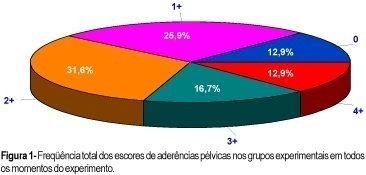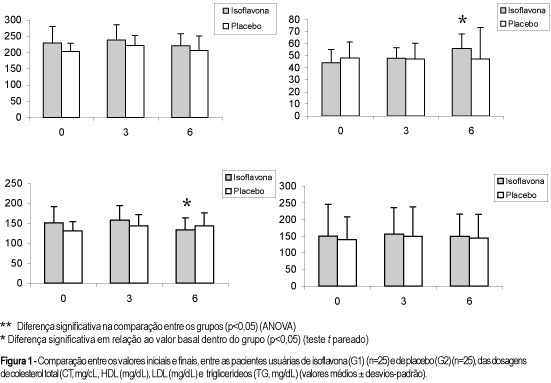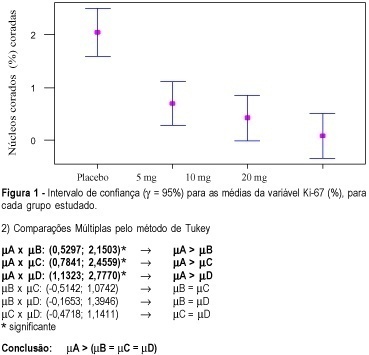Summary
Revista Brasileira de Ginecologia e Obstetrícia. 2000;22(7):435-441
DOI 10.1590/S0100-72032000000700006
Purpose: to describe sociodemographic characteristics of a group of climacteric women in order to discover the frequency and the variables associated with obesity and android profile of body fat distribution. Methods: an observational study was carried out in 518 patients aged 45 to 65 years, in a climacterium outpatient clinic. Age, color, menopausal status, duration of menopause, physical activity, smoking status, diet, alcohol intake, personal and family antecedents of arterial hypertension, diabetes mellitus, cardiovascular disease, dyslipidemia and obesity were considered. Body mass index and the waist/hip ratio were the dependent variables. For the statistical analysis Wilcoxon test, Pearson's correlation coefficient, with a 5% level of significance, and multivariate analysis using regression model were used. Results: more than two thirds of the participants were nonobese with an android profile and postmenopausal. One fourth had physical activity and were smokers; half reported an inadequate diet and one fifth were alcoholics. Patients with an android profile presented higher mean age than women with gynecoid pattern. Personal antecedents of obesity, arterial hypertension, diabetes and family history of diabetes were related to obesity and android pattern. Postmenopausal status was significantly associated with the android profile. Conclusions: the majority of the participants were nonobese with an android profile, white, postmenopausal, sedentary, neither smokers nor alcoholics. The main factors related to obesity and android pattern were personal antecedents of obesity, arterial hypertension, diabetes, family history of diabetes and particularly, postmenopausal status with android profile.
Summary
Revista Brasileira de Ginecologia e Obstetrícia. 2000;22(7):421-428
DOI 10.1590/S0100-72032000000700004
Purpose: to evaluate 24 cases of gastroschisis, in relation to the prognostic factors that interfered with postnatal outcome. Patients and Method: twenty-four pregnancies with fetal prenatal ultrasound diagnosis of gastroschisis, during an 8-year period, were analyzed. Gastroschisis was classified into isolated, when there were no other structural abnormalities, or associated, when other abnormalities were present. For both groups the following parameters were examined: ultrasound bowel dilatation (>18 mm), obstetric complications and postnatal outcome. Nonparametric Mann-Whitney and exact Fisher's tests were used for statistical analyses. Results: in 9 cases (37.5%) gastroschisis was associated with other abnormalities, and in 15 cases it was isolated (62.5%). All cases of associated gastroschisis had a letal prognosis, therefore the overall mortality rate was 60.8%. In the group of isolated gastroschisis, all were born alive and were submitted to surgery, but the survival rate after surgical correction was 60%. The median gestational age at birth was 35 weeks and birth weight 2,365 grams. Premature delivery was observed in 10 cases, mainly as a consequence of obstetric complication. Two newborns were small for gestational age, and only 3 had birth weight >2,500 grams. Oligohydramnios was found in 46.6% and it was more frequent in the group of postnatal death (66.7%). Ultrasound assessment of bowel showed bowel dilatation in 86.6%, however, without relation to the prognosis and postnatal bowel findings. There was no significant difference between gestational age at birth and birth weight comparing the survivor and postnatal death groups. Conclusions: isolated gastroschisis had a better prognosis when compared to associated, therefore this prenatal differentiation is important. Isolated gastroschisis was often associated with prematurity, small birth weight and obstetric complications. Prenatal diagnosis allows better monitoring of fetal and obstetric conditions. Delivery should be at term, unless presenting with obstetric complications.
Summary
Revista Brasileira de Ginecologia e Obstetrícia. 2003;25(5):359-364
DOI 10.1590/S0100-72032003000500009
PURPOSE: to evaluate the degree of pelvic adhesions in function of time and the different substances used in its prophylaxis. MATERIAL AND METHODS: prospective study with 120 female, albino, virgin Wistar rats, 3 to 4 months of age, weighing approximately 250 g, randomly divided into 10 groups of 12 animals each: control, without lesion; lesions and without treatment; lesions + 0.9% physiologic saline, lesions + Ringer lactate; lesions + 32% dextran 70; lesions + Ringer lactate/heparin; lesions + Ringer lactate/dexamethasone; lesions + Ringer lactate/hydrocortisone/dexamethasone/ampicillin; lesions + Ringer lactate/albumin, and lesions + 1% carboxymethylcellulose. The animals were anesthetized and two types of lesions (scarification and electrocauterization) were performed in the uterine horns, followed by treatment with the solutions, intraperitoneally, to prevent pelvic adhesions. On the 7th, 14th and 28th postoperative days, moments M1, M2 and M3, respectively, the presence of adhesions was evaluated in 4 rats of each group. The methods applied to the quantification of the adhesions were based on Cohen's classification, with scores varying from 0 to 4+ according to the amount, characteristics and location of the adhesions. Statistical analysis was performed by parametric tests for analysis of variance and the Kruskal-Wallis test. RESULTS: the best treatments for prevention of pelvic adhesions in female rats were Ringer lactate/dexamethasone (score 1+ prevalence), 32% dextran 70 to (score 2+ prevalence) and Ringer lactate/hydrocortisone/dexamethasone/ampicillin (score 2+ prevalence). The postoperative period, represented by moment M3, and the surgical technique, predominantly with score 0, influenced adhesiolysis and maintenance of pelvic adhesions in female rats. CONCLUSIONS: the prevention of pelvic adhesions in female rats begins with the surgical process at a smaller extent of tissue damage. The use of prophylactic substances (solutions) had a varied effectiveness, since some were more efficient than others.

Summary
Revista Brasileira de Ginecologia e Obstetrícia. 2003;25(5):345-351
DOI 10.1590/S0100-72032003000500007
PURPOSE: to estimate the sensitivity, specificity and accuracy of patient age, ultrasound result and CA-125 marker variables for the differential diagnosis between malignant and benign ovarian tumors. In addition, to establish a risk of malignancy index (RMI) incorporating these three variables and to estimate its sensitivity, specificity and accuracy for the differential diagnosis. METHODS: one hundred patients with ovarian tumors with surgical indication were included. The age, ultrasonographic findings and CA-125 level variables were evaluated separately and later on together as the RMI. The study was performed based on the evaluation of the sensitivity, specificity and diagnostic accuracy and the use of the measurements: likelihood ratio, odds ratio, and the Student's t test, chi², and logistic regression with univariate and multivariate analysis. RESULTS: for the age variable, sensitivity, specificity and diagnostic accuracy were 58.8, 68.2 and 65.0%, respectively. For ultrasound, 88.2, 77.3 and 81.0%. For CA-125 dosage, the values were 64.7, 74.2 and 71.0%. When the three variables were put together, as the RMI, a sensitivity of 76.5%, a specificity of 87.9% and a diagnostic accuracy of 84.0% were observed. CONCLUSIONS: RMI, made up of the association of patient age, ultrasound results and CA-125 dosage variables is a valuable indicator to distinguish between malignant and benign ovarian tumor, especially in regard to its specificity.
Summary
Revista Brasileira de Ginecologia e Obstetrícia. 2003;25(5):337-343
DOI 10.1590/S0100-72032003000500006
PURPOSE: to evaluate the effects of soy germ isoflavone on menopausal symptoms and blood lipids in postmenopausal women. METHODS: a prospective study was performed on 50 women, randomly divided into two groups: 25 women on soy germ isoflavones (60 mg/day, capsules) (G1) and 25 women on placebo (G2). Inclusion criteria: women with hot flushes and FSH >40 mIU/mL, non-vegetarian, non-smoker, non-Asiatic, not in use of hormone replacement therapy and without disease of the gastrointestinal tract. For six months, the menopausal Kupperman index (MKI) and hormonal and lipid profiles were assessed. For statistical analysis, ANOVA, t test and the non-parametric Kruskal-Wallis and Mann-Whitney tests were used. RESULTS: the median MKI values, initially similar in both groups, decreased in G1 at two and four months (MKI = 14 and 9, respectively), and in G2 at two months (MKI = 15) (p<0.01). At six months, isoflavone was significantly superior to placebo in reducing hot flushes (44 versus 12%, respectively). At the end of the study, in the isoflavone group, an increase in estradiol levels (from 16,8±7.3 to 18,0±6.7 ng/dL) (p<0.05) was observed, with no alteration in FSH, LH and vaginal cytology; there was also a reduction of 11.8% in LDL (from 151.5±39.2 for 133,6±26.4 mg/dL) and a HDL increase of 27.3% (from 44.0±11.3 to 56.0±11.9 mg/dL) (p<0.05). CONCLUSIONS: soy germ isoflavone induced favorable effects on menopausal symptoms and lipid profile, showing to be an interesting option for alternative therapy in postmenopausal women.

Summary
Revista Brasileira de Ginecologia e Obstetrícia. 2003;25(3):193-200
DOI 10.1590/S0100-72032003000300008
PURPOSE: to evaluate the diagnostic procedures used in women with Pap smear result of atypical glandular cells. PATIENTS AND METHODS: a prospective study with 159 women with atypical glandular cells was carried out between January and December 2000. All women were submitted to a new colpocytology and to colposcopy. Directed biopsy was performed in 50 cases, endocervical curettage in 21 and conization in 75. The performance of the diagnostic procedures was described by estimating the sensitivity, specificity, predictive values and likelihood ratio, considering histological results as gold standard. RESULTS: the histological evaluation showed 51 intraepithelial squamous lesions, 29 low grade and 22 high grade. Five women presented in situ adenocarcinoma and six patients presented invasive neoplasias. Colpocytology alone showed sensitivity and specificity of 88.5 and 39%, respectively, and colposcopy alone, 74 and 42%. The association of colpocytology with colposcopy increased the sensitivity to 98.4%, with a significantly lower specificity of 10%. Endocervical curettage showed low sensitivity (25%). CONCLUSION: the presence of atypical glandular cells on colpocytology was associated with preinvasive and invasive cervical lesions in 62.2% of the cases with histological evaluation. Repeating colpocytology and performing colposcopy allowed to select the women who needed histological evaluation. Conization was an adequate procedure when examination continued to show morphologic alterations.
Summary
Revista Brasileira de Ginecologia e Obstetrícia. 2003;25(3):185-191
DOI 10.1590/S0100-72032003000300007
PURPOSE: to quantitatively analyze the immunoreaction of monoclonal antibody Ki-67 in the mammary epithelium adjacent to fibroadenoma of premenopausal women treated with tamoxifen, for 50 days, at doses of 5, 10 and 20 mg/day. METHODS: we studied, prospectively, the effects of tamoxifen administered for 50 days, at doses of 5, 10 e 20 mg/day, by the immunoreaction of the Ki-67 (clone Ki-S5) monoclonal antibody on mammary epithelium adjacent to fibroadenoma in premenopausal women. We studied 58 patients in a double-blind trial who were divided into four groups: Group A (n=13; placebo), Group B (n=16; 5 mg/day tamoxifen), Group C (n=14; 10 mg/day) and Group D (n=15; 20 mg/day). All patients received the medication from the first day on of the menstrual cycle and biopsy was performed on the last day of the treatment. Cells stained and not stained by the immunoreagent were counted by optical microscopy (400X) with a digital image capturing system and image analysis. RESULTS: the average percentage of stained nuclei was calculated for all groups: Group A was 2.0 with a standard error (SE) of 0.3. In Group B it was 0.7 (SE=0.2); in Group C it was 0.4 (SE=0,2) and in Group D it was 0.1 (SE=0). Statistical analysis showed significant reductions between the groups (p<0.001), and Tukey's pairwise comparison test confirmed that there was a significant increase in the immunoreaction of the monoclonal Ki-67 antibody in groups B, C and D. CONCLUSIONS: tamoxifen, administered at doses of 5, 10 and 20 mg/day for 50 days, significantly reduced the immunoreaction of monoclonal Ki-67 in the mammary epithelium of premenopausal patients and there was no significant difference between the groups that received 5, 10 and 20 mg/day tamoxifen.
